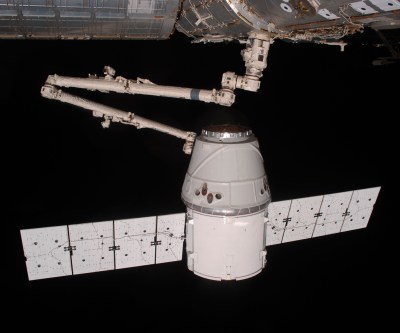We make no claims to be an expert on anything, but we do know that rule number one of working with big, expensive, mission-critical equipment is: Don’t break the big, expensive, mission-critical equipment. Unfortunately, though, that’s just what happened to the Deep Space Network’s 70-meter dish antenna at Goldstone, California. NASA announced the outage this week, but the accident that damaged the dish occurred much earlier, in mid-September. DSS-14, as the antenna is known, is a vital part of the Deep Space Network, which uses huge antennas at three sites (Goldstone, Madrid, and Canberra) to stay in touch with satellites and probes from the Moon to the edge of the solar system. The three sites are located roughly 120 degrees apart on the globe, which gives the network full coverage of the sky regardless of the local time.
nasa313 Articles
Hackaday Links: October 12, 2025
We’ve probably all seen some old newsreel or documentary from The Before Times where the narrator, using his best Mid-Atlantic accent, described those newfangled computers as “thinking machines,” or better yet, “electronic brains.” It was an apt description, at least considering that the intended audience had no other frame of reference at a time when the most complex machine they were familiar with was a telephone. But what if the whole “brain” thing could be taken more literally? We’ll have to figure that out soon if these computers powered by miniature human brains end up getting any traction.
A New Generation Of Spacecraft Head To The ISS
While many in the industry were at first skeptical of NASA’s goal to put resupply flights to the International Space Station in the hands of commercial operators, the results speak for themselves. Since 2012, the SpaceX Dragon family of spacecraft has been transporting crew and cargo from American soil to the orbiting laboratory, a capability that the space agency had lost with the retirement of the Space Shuttle. Putting these relatively routine missions in the hands of a commercial provider like SpaceX takes some of the logistical and financial burden off of NASA, allowing them to focus on more forward-looking projects.

But as the saying goes, you should never put all of your eggs in one basket. As successful as SpaceX has been, there’s always a chance that some issue could temporarily ground either the Falcon 9 or the Dragon.
While Russia’s Progress and Soyuz vehicles would still be available in an emergency situation, it’s in everyone’s best interest that there be multiple backup vehicles that can bring critical supplies to the Station.
Which is precisely why several new or upgraded spacecraft, designed specifically for performing resupply missions to the ISS and any potential commercial successor, are coming online over the next few years.
In fact, one of them is already flying its first mission, and will likely have arrived at the International Space Station by the time you read this article.
Continue reading “A New Generation Of Spacecraft Head To The ISS”
Hackaday Links: September 14, 2025
Is it finally time to cue up the Bowie? Or was the NASA presser on Wednesday announcing new findings of potential Martian biosignatures from Perseverance just another in a long line of “We are not alone” teases that turn out to be false alarms? Time will tell, but from the peer-reviewed paper released simultaneously with the news conference, it appears that biological activity is now the simplest explanation for the geochemistry observed in some rock samples analyzed by the rover last year. There’s a lot in the paper to unpack, most of which is naturally directed at planetary scientists and therefore somewhat dense reading. But the gist is that Perseverance sampled some sedimentary rocks in Jezero crater back in July of 2024 with the SHERLOC and PIXL instruments, extensive analysis of which suggests the presence of “reaction fronts” within the rock that produced iron phosphate and iron sulfide minerals in characteristic shapes, such as the ring-like formations they dubbed “leopard spots,” and the pinpoint “poppy seed” formations.
TFINER Is An Atompunk Solar Sail Lookalike
It’s not every day we hear of a new space propulsion method. Even rarer to hear of one that actually seems halfway practical. Yet that’s what we have in the case of TFINER, a proposal by [James A. Bickford] we found summarized on Centauri Dreams by [Paul Gilster] .
TFINER stands for Thin-Film Nuclear Engine Rocket Engine, and it’s a hoot. The word “rocket” is in the name, so you know there’s got to be some reaction mass, but this thing looks more like a solar sail. The secret is that the “sail” is the rocket: as the name implies, it hosts a thin film of nuclear materialwhose decay products provide the reaction mass. (In the Phase I study for NASA’s Innovative Advanced Concepts office (NIAC), it’s alpha particles from Thorium-228 or Radium-228.) Alpha particles go pretty quick (about 5% c for these isotopes), so the ISP on this thing is amazing. (1.81 million seconds!) Continue reading “TFINER Is An Atompunk Solar Sail Lookalike”
NASA Seeks Volunteers To Track Artemis II Mission
As NASA’s Artemis program trundles onwards at the blazing pace of a disused and very rusty crawler-transporter, the next mission on the list is gradually coming into focus. This will be the first crewed mission — a flyby of the Moon following in the footsteps of 1968’s Apollo 8 mission. As part of this effort, NASA is looking for volunteers who will passively track the Orion capsule and its crew of four as it makes its way around the Moon during its 10-day mission before returning to Earth. Details can be found here.
This follows on a similar initiative during the Artemis I mission, when participants passively tracked the radio signals from the capsule. For this upcoming mission NASA is looking for Doppler shift measurements on the Orion S-band (2200-2290 MHz) return link carrier signals, with the objective being to achieve and maintain a carrier lock.
Currently penciled in for a highly tentative April 2026, the Artemis II mission would fly on the same SLS Block 1 rocket configuration that launched the first mission, targeting a multi-trans-lunar injection (MTLI) profile to get to the Moon using a free return trajectory. The crew will check out the new life support system prior to starting the MTLI burns.
Because Artemis II will be on a free return trajectory it will not be orbiting the Moon, unlike Apollo 8’s crew who made ten lunar orbits. Incidentally, Apollo 8’s crew included James Lovell, who’d go on to fly the world-famous Apollo 13 mission. Hopefully the Artemis astronauts will be spared that level of in-space excitement.
NASA Is Taking Suggestions For Raising Swift’s Orbit
Launched in 2004, the Neil Gehrels Swift Observatory – formerly the Swift Gamma-Ray Burst Explorer – has been dutifully studying gamma-ray bursts (GRBs) during its two-year mission, before moving on to a more general space observation role during its ongoing mission. Unfortunately, the observatory is in LEO, at an altitude of around 370 km. The natural orbital decay combined with increased solar activity now threatens to end Swift’s mission, unless NASA can find someone who can boost its orbit.
Using Swift as a testbed for commercial orbit-boosting technologies, NASA is working with a number of companies to investigate options. One of these is the SSPICY demonstration of in-orbit inspection technology by Starfish Space that’s part of an existing Phase III program.
Although currently no option has been selected and Swift is still at risk of re-entering Earth’s atmosphere within the near future, there seems to be at least a glimmer of hope that this process can be reverted, and a perfectly fine triple-telescope space observatory can keep doing science for many years to come. Along the way it may also provide a blueprint for how to do the same with other LEO assets that are at risk of meeting a fiery demise.















